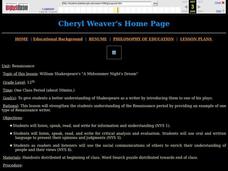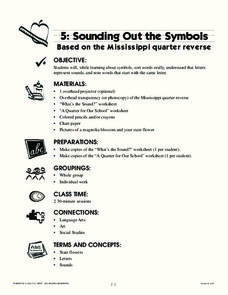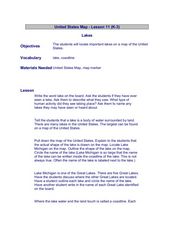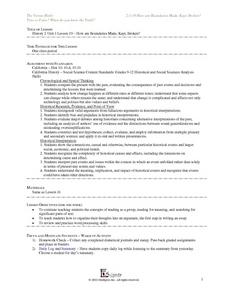Curated OER
Amelia Earhart Putnam
Students travel the world with Amelia Earhart, mapping out their own route and then comparing it to the one she flew as she attempted to circle the earth in an airplane. They apply military time as it pertained to Earhart's disappearance.
Curated OER
This Land is My Land, That Land is Your Land!
Pupils explore the Native American migrant experience in the United States. They define and describe reservation and the relationship between the U.S. Government and Native tribes through individual textbook research and class discussion.
Curated OER
Magellan
Students identify the route of Magellan's voyage. In this map skills lesson, students use a globe to identify various coordinates where Magellan traveled.
Curated OER
Famous Olympians
Students study about famous Olympic athletes. They are introduced to a few that have earned gold medals to encourage interest. Students read to find out more about them to become with more equally famous Olympic Games stars.
Curated OER
Timed Multiplication Test Graphs
Students use the tools of data analysis for managing information. They solve problems by generating, collecting, organizing, displaying histograms on bar graphs, circle graphs, line graphs, pictographs and charts. Students determine...
Curated OER
Social Studies For Elementary School
Fourth graders become familar with maps and work in groups to get an overview of what Europe is like. The real assignment is in the form of students creating their own trip if it could really be taken.
Curated OER
Current Connections
Many of us read our history books and take each word as truth. Show learners that history can easily be altered depending on who writes it. Your class will watch a series of videos, read a first person testimony, and discuss the...
Curated OER
Quarter Sorter
Graphing and sorting are such important skills for young learners to understand. Here, they will be given quarters to examine, they must come up with a sorting rule by which they will use to sort the quarters. They will sort their...
Curated OER
Centripetal Force
In order to investigate cetntripetal force and angular momentum, youngsters compare the motion of erasers hung from a string. It is not clear what type of Amish toy is needed in the warm up activity, so you may not be able to use it. The...
Curated OER
A Midsummer Night's Dream
You might not be able to put a girdle around the earth in forty minutes but you can generate interest in A Midsummer’s Night Dream in that length of time. As an introduction to Shakespeare’s comedy, pairs of students assume the roles of...
Curated OER
Food & Science - How Healthy is Your Diet?
Learners experiment with various foods to determine fat and starch content. They rub jam, peanut butter, bananas, and other foods in a small circle on a piece of paper, and observe the results. If there is a high fat content in the...
Curated OER
Sounding Out the Symbols
Using the states as a hook, kindergartners identify beginning sounds. They identify the initial sound in words like Mississippi and Indiana and complete a set of worksheets related to this skill.
Curated OER
Latitude and Longitude
Students find latitude and longitude on a map or atlas. They create maps with a cruise route. They practice plotting locations given latitiude and longitude.
Curated OER
Social Studies: Aztec Calendars and Culture
Sixth graders analyze the Aztec calendar and create their own examples of them. They determine the meaning of the symbols used in the calendars and record their ideas in journals. Students host a parent breakfast for them to observe...
Curated OER
United States Map - Lesson 11
Students explore lakes of the United States. In this geography lesson plan, students identify noteworthy lakes on a map of the United States.
Curated OER
The Changing Landscape
Students explore how the landscape is constantly changing. In this landscape lesson, students identify a building under construction on the Landscape Picture Map. Students discuss the purpose of the construction and the effect on the...
Curated OER
Farms And Cities
Students differentiate the differences of living on a farm or in a city. They do this with the use of coloring pictures and have group discussion about each picture to identify characteristics and identify where the picture is from. The...
Curated OER
1920s Variety Show
To better understand the cultural achievements of the Harlem Renaissance and become familiar with its major figures, class members examine a painting by Aaron Douglas and a poem by Langston Hughes and compare how the artists develop...
Curated OER
Columbus' Voyage to the New World
Students develop cooperation skills and to teach rules and how to follow them. Students create voyage card. They discuss and decide on some situations that may have or did occur to the crew during Columbus voyage to the new world. ...
Curated OER
Outnumbered by the English
Learners examine how the English eventually outnumbered the Native Americans and gained control. They participate in a demonstration using circles and fractions to discuss how the Native Americans were forced off their land, and examine...
Curated OER
How Are Boundaries Made, Kept, Broken?
Students write a first draft of an essay reflecting their opinions of Things Fall Apart. They complete their circle diagrams, have them approved by the teacher, and write their essays. They write in their dialectical journals as they...
Curated OER
North or South? Which has a better way of life?
Sixth graders brainstorm what they believe are the causes of the Civil War. They copy the blank circle graph into their Social Studies journals twice once for their prediction and once for the actual. Students list the following...
Curated OER
How Did Civil War Soldiers Battle Boredom?
Pupils create a Venn diagram to show how they and combat soldiers during the Civil War dealt with boredom. They discover what the soldiers did to help time pass. They use the Internet to gather information.
Curated OER
How History Changed the Way We Eat
Students participate in a lesson that is concerned with the history of the food pyramid and how it evolved and changed into its modern state. After being presented with the information they conduct classroom discussions about the research.

























